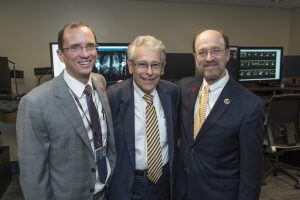
Greg Hundley, M’88 (left), Pauley Heart Center inaugural director, with former cardiology chair George Vetrovec, M.D., H’74, F’76 (center), and current cardiology chair Kenneth Ellenbogen, M.D.
In the early 1980s, a bright-eyed William & Mary undergraduate took the bus from Williamsburg, Va., to Richmond on a whim. He was thinking of becoming a doctor and wanted to get a feel for the MCV Campus. He wandered the floors of Sanger Hall and happened upon the office of then-cardiology professor Hermes A. Kontos, M.D., H’62, PhD’67 (PHIS).
“Hi, I’m Greg Hundley.”
He explained his interest in medicine and asked if he could work for Kontos that summer. Kontos, as he had done for many students before, said he had a perfect project for the aspiring physician.
It marked the start of a years-long mentorship that continued during Hundley’s undergraduate and medical school years as he worked in the lab with Kontos, who would go on to become dean of the medical school and later vice president for health sciences and CEO of VCU Health System.
“It was a blessing because when I started medical school, other students were trying to get into a lab and I was thrilled to already be working with one of the most famous people here,” laughs Hundley, M’88. “It was just happenstance.”
What wasn’t happenstance was his return to his alma mater in July 2018 as the inaugural director of the VCU Pauley Heart Center. Now a longtime leader in the field of cardiovascular imaging, Hundley was the first in the world to use magnetic resonance imaging to demonstrate that MRI stress testing can identify those at risk of heart attack. He’s also recognized for studying the impact of chemotherapy and radiation therapy on heart health, advancing treatment options for patients in need of cardiovascular and oncology care.
“He is going to do wonderful things for the Pauley Heart Center,” says former cardiology chair George Vetrovec, M.D., H’74, F’76. “Having his specialized and internationally recognized expertise related to cardiology imaging will significantly improve our research opportunities and recruitment of trainees. It really moves the Pauley Heart Center forward and is going to have an impact for Massey Cancer Center as well. It’s a win-win.”
The two men have known each other for years – “In fact, I tried to recruit him here a couple of times,” Vetrovec says — and share a common mentor in Kontos. Hundley’s appointment became even sweeter when he was named the first holder of the George Vetrovec Chair in September.
“It’s very special to have the chair and then for the first scholar to be a leader like Dr. Hundley, who I know and respect,” Vetrovec says. “There couldn’t be a better match.”
The significance isn’t lost on Hundley, who cites the work of professor emeritus David Richardson, M.D., H’55, as well as Kontos and Vetrovec, as a legacy he will work hard to further in his new role. “Those men are giants in their own right in the field of cardiovascular medicine.”
Hundley’s arrival marks the opening of a new Cardiovascular Imaging Suite made possible by an investment from the Pauley Family Foundation. The cornerstone of the suite is a Magnetom Vida 3 Tesla (3T) MRI system that increases accuracy of diagnosis, reduces image distortion and enhances opportunities to develop personalized treatment plans.
Hundley compares it to high-definition television. “You can appreciate anatomy, where everything is, what the structure is, what the function is. When those processes are broken we can understand the exact cause of the heart not working properly, producing two great outcomes. First, doctors get to clearly see what the problem is, and second, patients also have that clear understanding so both can work together to come up with a solution to prevent cardiovascular complication.”
The 3T MRI takes nine seconds to produce 15, high-def images. It’s a long way from the days when Hundley would wait nine minutes for one image and then stay up all night to code its results.
Exploring the ways patients can benefit from high-def imaging is what inspires Hundley’s research. In the past 20 years, he’s participated in research funded by more than $71 million in National Institutes of Health grants.
As he brings his next-level technology expertise and research to the MCV Campus, Hundley also hopes to hold on to the values instilled in him by mentors like Kontos.
“He really encouraged me to shoot and aim high,” Hundley says. “I want to do for everybody else what he and others who came before have done for me.”
Vetrovec has no doubt Hundley will rise to the challenge.
“I’m sure he’ll do it and then some.”
By Polly Roberts